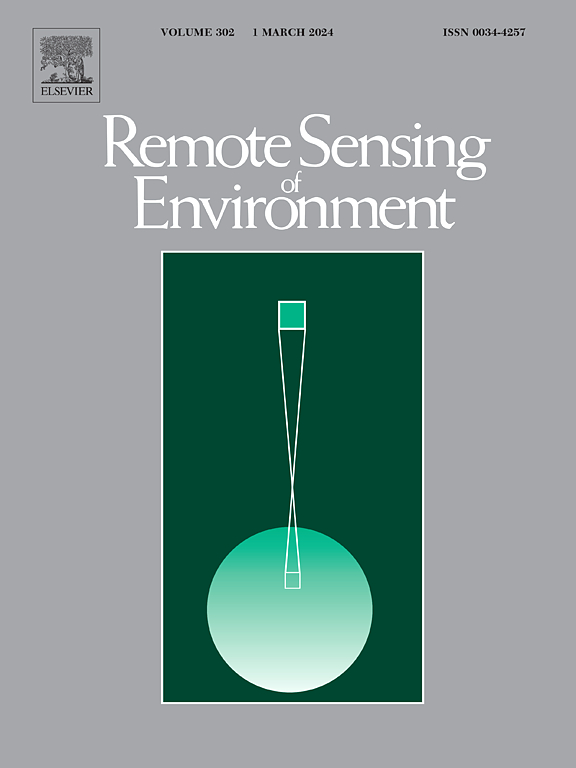Use of close-range LiDAR devices and statistical inference approaches in operational stand-level forest inventories
IF 11.1
1区 地球科学
Q1 ENVIRONMENTAL SCIENCES
引用次数: 0
Abstract
Close-range LiDAR devices are considered to have great potential for enhancing forest inventory (FI) estimates. However, this potential is still being explored in the case of ground-based LiDAR devices, especially when the target is focused on relatively large spatial scales, such as stand level. This study explored the performance of close-range LiDAR devices in terms of bias and error, particularly terrestrial laser scanning (TLS) instruments, as measurement tools in stand-level FIs. The main premise of the research is that close-range LiDAR devices provide auxiliary information that can be used to accurately and precisely predict the dependent variable of the target population, thereby reducing errors. To this end, this study compared the performance of different statistical inference approaches that can be implemented with these technologies, such as the simple expansion estimator (EXP), two-stage model-assisted regression (REG), conventional model-based (CMB) and three-phase hierarchical model-based (3pHMB) approaches. These approaches were used to compare the following types of data: field measurements and TLS single-scan data (EXP, REG); field measurements and unmanned aerial vehicles (UAV)-LiDAR data (CMB); and field measurements, TLS single-scan data and UAV-LiDAR data (3pHMB). The case study was carried out in a 16 ha experimental plot dominated by Pinus radiata and Pinus pinaster in northwest Spain, focusing on stand volume (, m3 ha−1) estimates. The findings showed that the use of close-range remote sensing devices as a source of auxiliary data provided lower error in estimates than the EXP approach using a single data source. The findings also suggest that close-range LiDAR devices can potentially be used as FI instruments. Therefore, the transfer of these sampling techniques may play an important role in operationalizing the use of close-range LiDAR devices in FIs.
近距离激光雷达设备和统计推断方法在林分水平森林清查中的应用
近距离激光雷达设备被认为具有提高森林清查(FI)估计的巨大潜力。然而,在地面激光雷达设备的情况下,这种潜力仍在探索中,特别是当目标集中在相对较大的空间尺度时,例如站水平。本研究探讨了近距离激光雷达设备在偏差和误差方面的性能,特别是地面激光扫描(TLS)仪器,作为林分水平fi的测量工具。研究的主要前提是,近距离激光雷达设备提供辅助信息,可用于准确准确地预测目标人群的因变量,从而减少误差。为此,本研究比较了这些技术可以实现的不同统计推断方法的性能,如简单扩展估计器(EXP)、两阶段模型辅助回归(REG)、传统基于模型的方法(CMB)和基于三相层次模型的方法(3pHMB)。这些方法用于比较以下类型的数据:现场测量和TLS单扫描数据(EXP, REG);现场测量和无人机(UAV)-激光雷达数据(CMB);现场测量,TLS单扫描数据和无人机-激光雷达数据(3pHMB)。本研究在西班牙西北部一个以辐射松(Pinus radiata)和松(Pinus pinaster)为主的16公顷试验地进行,重点研究林分体积(VV, m3 ha - 1)估算。研究结果表明,与使用单一数据源的EXP方法相比,使用近距离遥感装置作为辅助数据来源的VV估计误差更小。研究结果还表明,近距离激光雷达设备有可能用作FI仪器。因此,这些采样技术的转移可能在fi中使用近距离激光雷达设备的操作中发挥重要作用。
本文章由计算机程序翻译,如有差异,请以英文原文为准。
求助全文
约1分钟内获得全文
求助全文
来源期刊

Remote Sensing of Environment
环境科学-成像科学与照相技术
CiteScore
25.10
自引率
8.90%
发文量
455
审稿时长
53 days
期刊介绍:
Remote Sensing of Environment (RSE) serves the Earth observation community by disseminating results on the theory, science, applications, and technology that contribute to advancing the field of remote sensing. With a thoroughly interdisciplinary approach, RSE encompasses terrestrial, oceanic, and atmospheric sensing.
The journal emphasizes biophysical and quantitative approaches to remote sensing at local to global scales, covering a diverse range of applications and techniques.
RSE serves as a vital platform for the exchange of knowledge and advancements in the dynamic field of remote sensing.
 求助内容:
求助内容: 应助结果提醒方式:
应助结果提醒方式:


